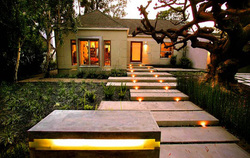
Often, low voltage circuits come with dimming switches to decrease energy consumption when full illumination is not required. They also often include built-in timers with auto on and off functions; this is especially useful for outdoor landscaping lighting and low voltage security lighting. These applications often demand electricity for longer periods of time compared to indoor artificial light. For this reason, energy efficiency is important. The built-in automatic timer will also add to the convenience of the lighting system.
lighting.
In fact, non-essential lighting such as these applications are required to be supplied by high efficacy luminaires by code. California title 24, section 6 for residential lighting, classifies types of lighting throughout the home and sets requirements as to what percentage must be high efficacy. For example, 50% of all kitchen lighting must be high efficacy and under cabinet lighting often exceeds this metric if it is not low voltage lighting. So by code, homeowners that fall under this applicable ordinance must have low voltage, LED under cabinet lighting.
One of the biggest advantages of low voltage lighting is its ease of installation and maintenance. This advantage is, in many ways, an evolution of all of the other advantages. It supplies small, cool burning luminaires such as LEDs, that last forever without replacement. Their plug and play design often allows the user to connect the transformer to a standard residential outlet receptacle. Without soldering or running dangerous conduit, connect link cables to fixtures in series and mount fixtures in the desired configuration.
 RSS Feed
RSS Feed